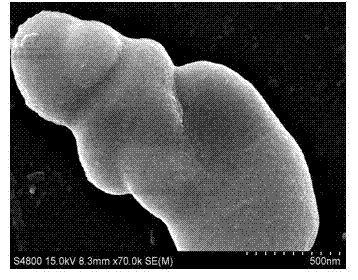Method for preparing graphene polyphosphazene nano composite material
A nano-composite material, a technology of polyphosphazene, applied in the field of nano-graphene functional materials, can solve problems such as graphene structural defects, affecting the excellent performance of graphene, etc., achieve low cost, easy to achieve large-scale production, and simple process conditions Effect
- Summary
- Abstract
- Description
- Claims
- Application Information
AI Technical Summary
Problems solved by technology
Method used
Image
Examples
Embodiment 1
[0022] Weigh 2.0 g of natural graphite in a reaction vessel, add 50 mL of concentrated sulfuric acid with a mass concentration of 95%, and add 6.0 g of KMnO 4 , react at low temperature for 2 hours; place in a constant temperature water bath at about 35°C, and continue to react at medium temperature for 1h; add 90 mL of deionized water, control the temperature at about 100°C, and continue to react at high temperature for 1h; then transfer the reaction solution into a beaker, and use The reaction solution was diluted with deionized water, and the mass concentration was 30% H 2 o 2 Solution until no bubbles are generated, the product is washed with acidic aqueous solution and deionized water respectively, and graphite oxide is obtained after vacuum drying.
[0023] 0.05g of graphite oxide was ultrasonically dispersed in 50ml of deionized water to obtain graphene oxide, and 5 mL of a mass concentration of 85% hydrazine hydrate solution was added thereto, placed in an oil bath at...
Embodiment 2
[0030] Weigh 2.0 g of natural graphite in a reaction vessel, add 50 mL of concentrated sulfuric acid with a mass concentration of 95%, and add 6.0 g of KMnO 4 , react at low temperature for 2 hours; place in a constant temperature water bath at about 35°C, and continue to react at medium temperature for 1h; add 90 mL of deionized water, control the temperature at about 100°C, and continue to react at high temperature for 1h; then transfer the reaction solution into a beaker, and use The reaction solution was diluted with deionized water, and the mass concentration was 30% H 2 o 2 Until no bubbles are generated, the product is washed with acidic aqueous solution and deionized water respectively, and graphite oxide is obtained after vacuum drying.
[0031] 0.05g of graphite oxide was ultrasonically dispersed in 50ml of deionized water to obtain graphene oxide, and 5 mL of a mass concentration of 85% hydrazine hydrate solution was added thereto, placed in an oil bath at 95°C for...
Embodiment 3
[0034] Weigh 2.0 g of natural graphite in a reaction vessel, add 50 mL of concentrated sulfuric acid with a mass concentration of 95%, and add 6.0 g of KMnO 4 , react at low temperature for 2 hours; place in a constant temperature water bath at about 35°C, and continue to react at medium temperature for 1h; add 90 mL of deionized water, control the temperature at about 100°C, and continue to react at high temperature for 1h; then transfer the reaction solution into a beaker, and use The reaction solution was diluted with deionized water, and the mass concentration was 30% H 2 o 2 Until no bubbles are generated, the product is washed with acidic aqueous solution and deionized water respectively, and graphite oxide is obtained after vacuum drying.
[0035] 0.05g of graphite oxide was ultrasonically dispersed in 50ml of deionized water to obtain graphene oxide, and 5 mL of a mass concentration of 85% hydrazine hydrate solution was added thereto, placed in an oil bath at 95°C for...
PUM
| Property | Measurement | Unit |
|---|---|---|
| thickness | aaaaa | aaaaa |
Abstract
Description
Claims
Application Information
 Login to View More
Login to View More - R&D
- Intellectual Property
- Life Sciences
- Materials
- Tech Scout
- Unparalleled Data Quality
- Higher Quality Content
- 60% Fewer Hallucinations
Browse by: Latest US Patents, China's latest patents, Technical Efficacy Thesaurus, Application Domain, Technology Topic, Popular Technical Reports.
© 2025 PatSnap. All rights reserved.Legal|Privacy policy|Modern Slavery Act Transparency Statement|Sitemap|About US| Contact US: help@patsnap.com



